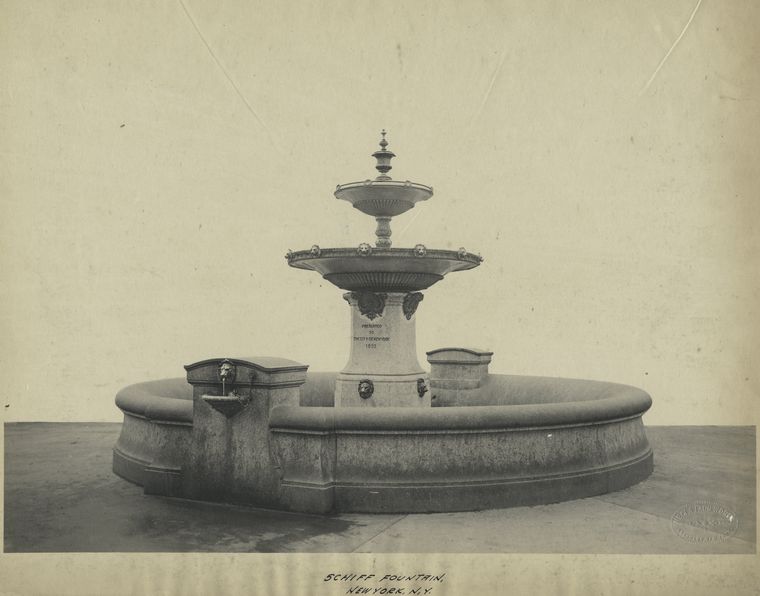By Anne M. Filiaci, Ph.D.
Seeking a better environment for her new neighbors, in 1894 Wald asked her patron, Jacob Schiff, to donate a fountain to Rutgers Square at the intersection of Canal Street and East Broadway. She supported her request by noting that the Square was not only a relatively healthy space, but also a popular gathering spot. “During the warm summer days,” she said, “the open place” was “a great congregating place for the surrounding tenement house population,” who “go there to get some of the fresh air of which they are so much in need.”
Schiff, after doing some investigation on his own, agreed to support the venture, “in order to give to the people who may come to the square the benefit always derived by the tired and overheated from a flow of fresh water.” Relying on his network of influential people, Schiff soon got “the necessary permission from the municipal authorities.” On November 2nd of 1894, he sent M. Warley Platzek (then Commissioner of Deeds for the City and County of New York), a sketch of the proposed fountain, stating that he would like to build it before summer. The Board of Aldermen and the Department of Public Works agreed to his terms and quickly approved his gift.
But the city’s approval did not necessarily mean that the project would be completed in an expeditious manner. Wald herself needed to intervene when one alderman seemed to be dragging his feet in the matter. Forsaking her upbringing as a middle-class lady, she found herself
obliged to enter the saloon of N—, the alderman of our district, to obtain the promise of necessary and long-delayed action on his part for the city’s acceptance of the gift of a street fountain, which I had been indirectly instrumental in securing for the neighborhood. I had been informed by his friends that without this attention he would not be likely to act.
Her pleas proved successful, and by late June of 1895, the fountain had been installed and was opened to the public.
Once the water was turned on, however, the fountain became “quickly…plugged up with banana peels, waste paper, and other refuge deposited therein by the gamins of the neighborhood.” Wald and Brewster stepped in to help when the “combined efforts of two policemen did not suffice to keep that unlucky fountain in running order.” They used their influence and the goodwill they had carefully developed, mobilizing “the boys of the neighborhood into a sort of watchman’s league for the purpose of preserving order” at the fountain. The boys “fell in with the suggestion quite readily and, along with “representatives of the City Vigilance League and the Good Government Clubs, gathered for a meeting at the Hebrew Institute, a meeting hosted by Superintendent Spectorsky”—a gentleman with whom Wald had already collaborated. Those who attended the meeting formed the Fountain League, with a “membership of 100 boys over twelve years old,” all of whom “pledged…to keep both fountain and square clean.” Promising to remain “on duty morning, noon and night,” they were determined “to see that the fountain is not defiled.”
Wald also brought City government into the mix. Teddy Roosevelt, who was then New York’s Police Commissioner and a friend to reformers, “promised to do all that he can to aid the boys , and Col. Waring of the Street Cleaning Department”–another hero of New York City reformers—furnished them with two steels, wherein to deposit the dead cats, old rags, banana and orange peels, and other flotsam and jetsam that has in the past mysteriously found its way into the recesses of the Rutgers Square fountain.
The young men were given official badges that proclaimed their status as guardians of the fountain. Once again, Wald—using persuasion, perseverance, and diligent attention to detail—had convinced her growing network of neighbors, friends, government officials, reformers and philanthropists to work together to shepherd a project to success.

Bibliography
Adler, Cyrus, Jacob H. Schiff: His Life and Letters, vols. I & II, Garden City, NY: Doubleday, Doran and Co., Inc., 1929
“Boys to Guard a Fountain: A Battalion of 100 will try to stop defilement in Rutgers Square—an Interesting Experiment,” New York Times, Sept. 27, 1895
New York (N.Y.). Board of Aldermen New York (N.Y.), Proceedings of the Board of Aldermen, Volume 215. [n.p.] Board of Aldermen The Board, 1894. Municipal government publications (free ebook through Google) (Appointments and reappointments of Commissioners of Deeds)
Wald, Lillian D., The House on Henry Street, NY: Henry Holt & Co., 1915
Wald, Lillian D., Lillian Wald Papers, New York: New York Public Library, [1983] (Microfilm)
Waldman, Benjamin, “A Philanthropist’s Forgotten Fountain in Seward Park in the Lower East Side” 09/26/2013 at http://untappedcities.com/2013/09/26/a-philanthropists-forgotten-fountain-in-seward-park-in-the-lower-east-side/ (includes illustrations. Current 6/3/15)
Illustrations
http://www.friendsofsewardpark.org/history-of-seward-park/schiff-fountain/
New York City Parks, Schiff Fountain, http://www.nycgovparks.org/parks/seward-park/monuments/1405 Current 6/3/15.
The Miriam and Ira D. Wallach Division of Art, Prints and Photographs: Print Collection, The New York Public Library. “Jacob H. Schiff fountain by Arnold W. Brunner. For description see page 129.” The New York Public Library Digital Collections. http://digitalcollections.nypl.org/items/a65293aa-67b4-f3ac-e040-e00a180606d8 (Current 6/3/15).
Science, Industry and Business Library: General Collection , The New York Public Library. “Schiff fountain [Seward Park], New York, N.Y.” New York Public Library Digital Collections. Accessed June 3, 2015. http://digitalcollections.nypl.org/items/510d47de-0fc5-a3d9-e040-e00a18064a99
Films
Edison, Thomas, “East Side Urchins Bathing in a Fountain,” accessed June 5, 2015 https://www.youtube.com/watch?v=JKakrTafAvw
Copyright 2015, Anne M. Filiaci